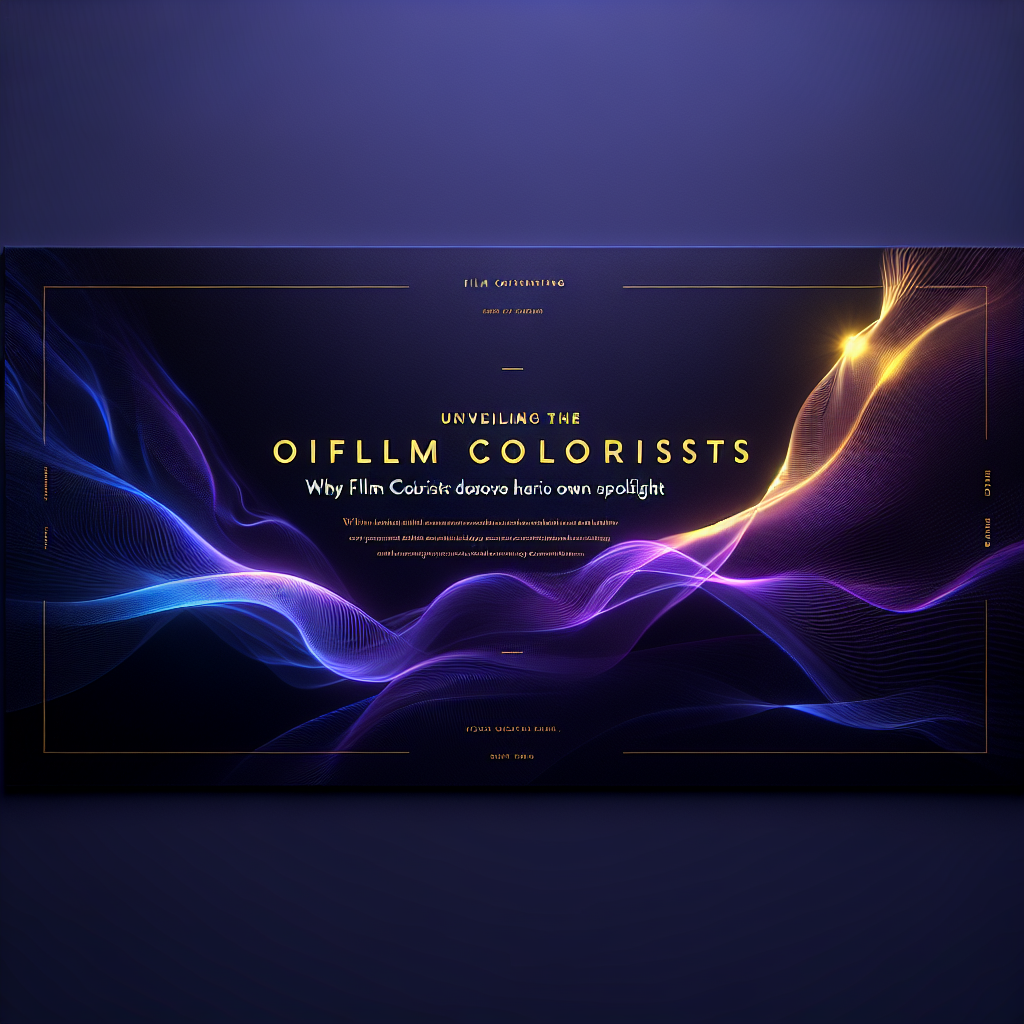In the realm of cinematic arts, a pivotal artist remains overlooked, their substantial contributions unnoticed by the industry’s highest accolades. Each year at the Dolby Theatre, we celebrate the directors, actors, cinematographers, and composers. Yet, as the coveted golden statuettes are bestowed, the film colorist—responsible for shaping a film’s emotional tone and visual identity through the backbone of color—remains in the background, their labor unrecognized and uncelebrated.
Colorists serve as the ultimate authors of motion pictures, crafting mood, movement, and meaning by meticulously adjusting color, light, and contrast on a shot-by-shot basis. They create atmospheres that amplify emotions and guide the viewer’s attention. In today’s landscape, where visual storytelling has reached new heights, the role of the colorist has transformed from a technical necessity into a refined art form. Neglecting this contribution fails to acknowledge the collaborative spirit of modern filmmaking; hence, it is time to advocate for the long-overdue addition of a new category at the Academy Awards: Best Achievement in Color Grading.
To understand the significance of today’s colorists, one must appreciate the transformation of color within cinema. In the early days of film, color was laboriously applied through hand-tinting and toning. The emergence of Technicolor in the 1930s introduced a vibrant aesthetic, yet creative control was often dictated by the chemical properties of film stock. The color timer, a precursor to the modern colorist, functioned primarily as a technician, fixing consistency between shots rather than exercising profound creative control.
A paradigm shift occurred during the digital revolution. As workflows transitioned from photochemical processes to digital intermediates in the late 1990s to early 2000s, colorists morphed into artists serious about their craft. Today, they work in sophisticated suites that resemble high-tech cockpits filled with calibrated monitors and control surfaces. Within these darkened rooms, they collaborate with directors and cinematographers to achieve the film’s intended visuals.
It is crucial to differentiate between color correction and color grading. Color correction lays the groundwork by balancing the light and color in each shot to create a seamless, natural appearance. Color grading transcends this technical foundation, involving artistic endeavors that define a film’s unique visual personality. If color correction prepares the canvas, color grading embodies the act of painting a masterpiece.
The influence of a skilled colorist on the final film is profound; their work becomes an integral aspect of storytelling, infusing imagery with depth and emotional impact that goes beyond dialogue or performance. Many powerful moments in contemporary cinema are a direct result of the color choices made during post-production.
For instance, in Christopher Nolan’s critical success, Oppenheimer, colorist Kostas Theodosiou expertly navigated dual narratives, utilizing vivid color for one of the timelines and black-and-white for the other. His grading offered both historical authenticity and reflected the ominous weight of the Manhattan Project, yielding an experience that is intellectually as well as emotionally haunting, a remarkable feat possible only through Theodosiou’s precise mastery.
In the adventurous multiverse of Everything Everywhere All at Once, colorist Alex Bickel was tasked with applying unique color signatures to diverse alternate universes, effectively grounding the reader’s emotional journey amidst chaotic shifts in the narrative. Through a flat, green-tinted look that indicated mundanity and dreamy saturation infused romance, Bickel helped craft viewers’ perceptions of the story’s constant transitions with striking clarity.
The power of color grading extends even to more understated, intimate films. In Chloé Zhao’s award-winning Nomadland, colorist Elodie Ichter developed a palette that authentically reflected the American West. By utilizing natural light and gentle tones, Ichter articulated the character’s environment without glorifying its harshness, establishing a visual tone that feels both documentary-like and profoundly lyrical.
Similarly, Peter Farrelly’s Green Book relied on colorist Walter Volpatto to evoke a nostalgic 1960s ambiance through vibrant tones reflective of vintage Kodachrome photography. His coloring not only encapsulated the period but acted as a narrative device, articulating the contrast between the warmth of Don Shirley’s northern upbringing and the stark realities of his journey through the South.
Even in Sean Baker’s gritty contemporary piece, Anora, colorist Alastor Arnold brought the film’s nightclub scenes to life with electric reds and pinks. As the narrative darkens, Arnold cleverly pulls back the saturation to unveil the film’s raw texture, a visual embodiment of the character’s emotional highs and lows.
These instances are not mere coincidences. The muted tones of Avengers: Endgame, where shadows and desaturation echo loss and sacrifice, or the soft pastels in Poor Things, which enhance the film’s surreal nature, testify that the colorist’s artistry permeates every frame. They shape perception, shape feelings, and ultimately shape comprehension, employing color to manifest emotions that performance or dialogue alone cannot convey.
The coordination between directors, cinematographers, and colorists is a deeply collaborative endeavor, forming a creative triangle. The director holds the overarching vision; the cinematographer captures light and composition during filming, while the colorist refines and elevates that artwork in post-production.
Roger Deakins, a renowned cinematographer with multiple Oscars to his name, has frequently emphasized the importance of collaborating with colorists. He states that the filmmaking process doesn’t culminate once filming ends; instead, it is within the digital intermediate suite where each image resonates into its final form. To honor cinematography without acknowledging the colorist is to present a fragmented narrative of a film’s creation.
This final stage transcends technicalities; it is an act of interpretation and translation. Film colorists interpret artistic intentions, balance competing visual elements, and rescue scenes that may not reflect the original vision. They serve as mediators between captured imagery and envisioned artistry, culminating in their role as the final architects of visual narratives, converting abstract intentions into coherent viewer experiences.
From a cognitive perspective, the film colorist significantly influences emotional responses through visual cues. Research indicates strong connections between specific colors and emotional states, illustrating that color’s effects are both culturally conditioned and biologically ingrained.
Detractors of a new Oscars category often present flawed arguments. Some contend that films can be produced and released without a dedicated colorist by utilizing raw footage. While this is accurate, it undermines the artistry that resides within the craft. Following the same logic, one could argue that films could be presented using the raw production audio without sound design, yet we still recognize artistry within the Best Sound category.
Similarly, a director may opt for in-camera effects, disregarding the transformative potential of digital post-production. Nonetheless, we celebrate the skill involved in Best Visual Effects. These categories exist not due to necessity but because the application of these crafts elevates films from mere recordings to masterful art. The contributions of colorists are vastly similar.
Moreover, the perception that the colorist’s influence is encapsulated within the Best Cinematography award fails to recognize the unique contributions of both roles. While cinematographers are responsible for the visual creation on set, colorists’ work reshapes and innovates these visuals entirely during post-production. To merge both roles is to overlook their distinct and critical artistry.
Conversations around acknowledging colorists are not novel; within the industry, their significance is widely recognized. The Hollywood Professional Association and the FilmLight Colour Awards have consistently celebrated outstanding color grading. Yet the Academy—the industry’s most prestigious and impactful institution—has remained muted. As visual complexity rises and audiences grow increasingly attuned to aesthetic quality, this silence has become glaring.
Imagine a future Oscar ceremony when the lights dim, and nominees for Best Achievement in Color Grading are announced. The screen will showcase clips from nominated films: a radiant romance, a chilling thriller, a gritty noir, and a fantastical adventure. In each, the ability of color to evoke transportive, terrifying, and captivating experiences will be celebrated. As the winner’s name is called, a new artist will emerge from the shadows, their craft finally acknowledged, their contributions celebrated.
This is not merely a call for an additional award; it represents a compelling case for the Academy to fulfill its mission as it nears its centenary. My plea is that in 2028, as the Academy celebrates a century of storytelling, it will also ignite inspiration for the future by embracing this essential craft. Honoring the colorist is about preserving the entirety of the artistic record, crafting an accurate account of cinematic history, and emotively connecting audiences to the final picture’s profound power. Colorists have articulated their masterpieces in the shadows for far too long; it is high time to illuminate their artistry fully.
Persons: Bobola Oniwura, Kostas Theodosiou, Alex Bickel, Elodie Ichter, Walter Volpatto, Alastor Arnold, Roger Deakins, Chloé Zhao, Christopher Nolan, Peter Farrelly
Company Names: Ingenuity Pictures, DaVinci Resolve
Titles: Oppenheimer, Everything Everywhere All at Once, Nomadland, Green Book, Anora
Disclaimer: This article has been auto-generated from a syndicated RSS feed and has not been edited by Vitrina staff. It is provided solely for informational purposes on a non-commercial basis.
































